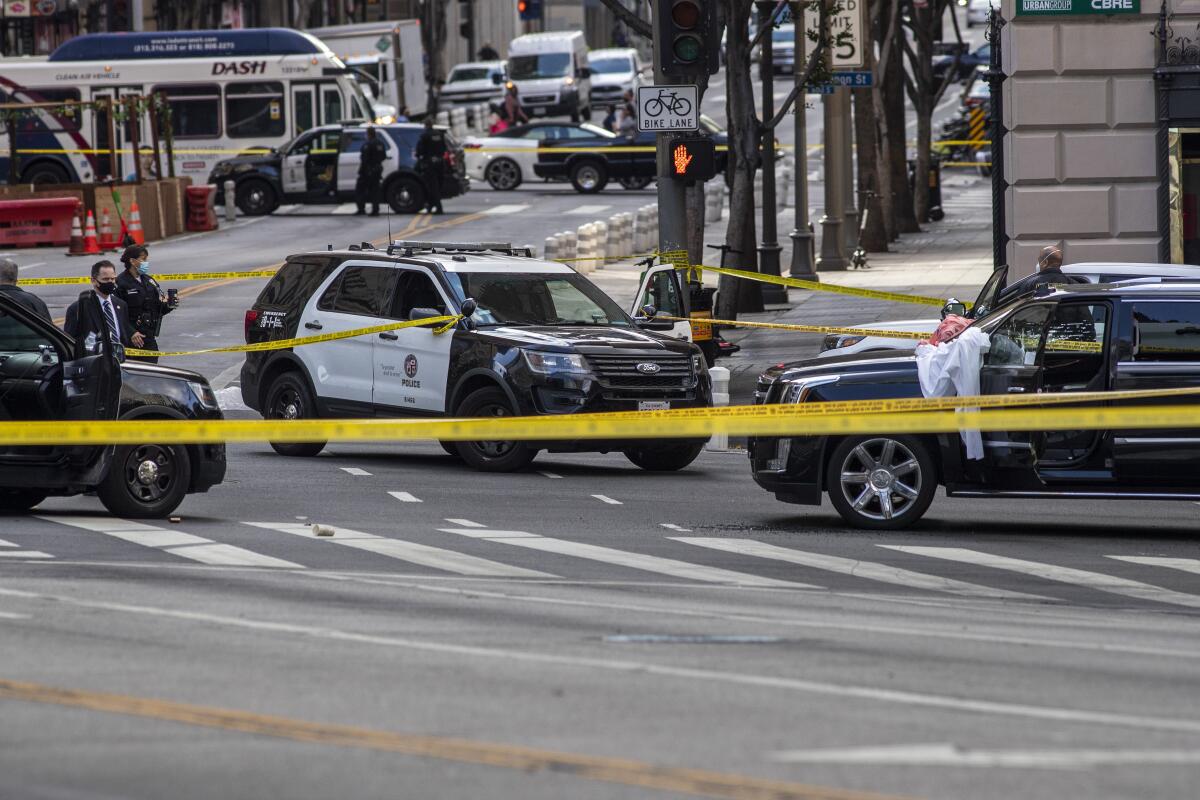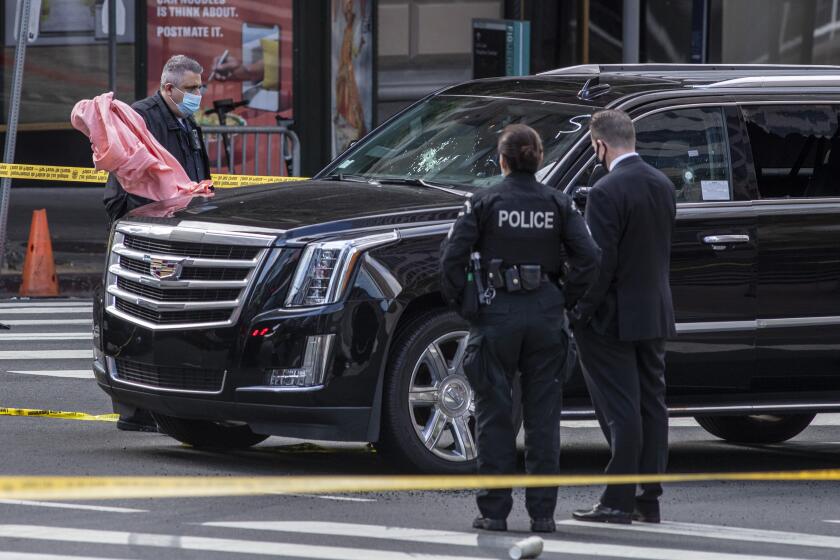Startling surge in L.A. bloodshed as COVID-19 fades: ‘Too many guns in too many hands’

- Share via
At Harbor-UCLA Medical Center, Dr. Brant Putnam has watched the intense weight of the COVID-19 pandemic finally begin to lift in recent months — only to be replaced by another, relentless stressor.
In the first four months of 2021, gunshot victims have arrived at a much greater rate than usual.
The Level 1 trauma center in Torrance treats about 3,500 patients a year; an average of 15% experience “penetrating trauma” such as a shooting or stabbing, said Putnam, chief of the trauma and acute care surgery division.
So far this year, the figure stands at 19%, he said. From Jan. 1 to April 27, the hospital treated 142 shooting victims, compared with 76 during the same period last year — an increase of nearly 87%.
“This has definitely been one of the most stressful times in my entire career,” said Putnam, a surgeon for 20 years who scrubs in and works 24-hour trauma shifts once or twice a week.
As COVID-19 began hospitalizing and killing more people in Los Angeles last year, so did shootings in the street. The increased bloodshed, much of it linked to gangs, surged as the economy faltered, leading to the deadliest year of violence in L.A. in a decade.
Surrounding areas of L.A. County saw similar increases in gun violence.
A man suspected in multiple shootings in Los Angeles that left two people dead was killed in a shootout in Fullerton after a police pursuit.
Now, four months into 2021, life is returning to normal in many quarters of the city as vaccination efforts drive down coronavirus infections, shutdown orders are lifted and businesses reopen.
The gun violence, however, is not receding.
According to Los Angeles Police Department data, the city as of Saturday had seen 465 shootings since Jan. 1, an almost 67% increase over the same period last year. Homicides, at 115 as of Sunday, were up more than 26%.
Police say gangs were often to blame; disputes at homeless encampments were another major factor. Victims have included people shot during robberies, drivers randomly shot in their cars and pedestrians gunned down on the street. A 12-year-old girl was shot at an outdoor birthday party; a 6-year-old boy was shot at an apartment building.
Last week, a man allegedly went on a rampage through the city, killing two and wounding two others in five separate shootings before being killed by police. An off-duty LAPD officer was shot in Sherman Oaks, police said, after he found a man burglarizing his car, whom he shot. And police announced five arrests in the February shooting of Lady Gaga’s dogwalker in Hollywood, an incident that highlighted an increase this year in the number of robbery victims being shot.
On Monday, LAPD detectives were investigating a morning shooting in Mid-City that left two men dead and a woman wounded, among other cases.
There are still far fewer shootings than there were in the 1990s in L.A., but scores more are dying than in more recent years, in the city and beyond.
Preliminary data from the L.A. County Sheriff’s Department show that homicides in surrounding areas increased by more than 113% in the first three months of this year, with 64 killings, compared with 30 during the same period in 2020. Aggravated assaults with guns, including shootings, jumped 82% during that time, from 255 to 465.
At weekly meetings this year of the civilian Police Commission, LAPD Chief Michel Moore has lamented the violence, ascribing blame to the wide availability of guns, including homemade ones known as ghost guns, despite gun arrests this year being up more than 90%.
“It’s frankly too many guns in too many hands,” Moore told the commission recently.
Moore also noted that more than a dozen homicide victims this year were homeless and said the LAPD has linked much of the violence to the “interchange between gang violence and homeless encampments, where we’ve seen an increase in retaliation and in disputes involving persons experiencing homelessness and narcotics sales.”
At the macro level, Moore has argued, the increased violence is inextricably linked to the pandemic, which has wreaked havoc on social safety nets and the economy, disrupted violence prevention efforts and blocked intervention workers from sitting at the bedsides of shooting victims, or next to their family members in emergency wards, to help prevent cycles of retaliation.
Five people were shot to death and a 70-year-old man was fatally beaten, police said.
Police officials across the country have noted similar forces, as their cities — big and small, led by Democrats and Republicans — also suffer under surging gun violence. Criminologists have pointed to the pandemic, and its multitude of impacts, as the only common element across the country.
Some in L.A. County cite other factors, such as policies from new Dist. Atty. George Gascón that are perceived as lenient on criminals or local pandemic-related rules to release prisoners and arrestees ahead of trial. But experts say those theories don’t explain the national surge.
As infection rates have declined in recent weeks, and restrictions on gatherings and other events have slowly lifted, Moore has expressed hope that the violence will wane.
Others hope so, too.
Anne Tremblay, the legal counsel to Mayor Eric Garcetti who until February directed his Gang Reduction and Youth Development office, said intervention workers and other peace ambassadors deserve tremendous credit for continuing their work through the pandemic.
But, she said, many have “Zoom fatigue” from trying to host conversations and mediate issues online and are eager to get back to hospital bedsides and to hosting events like Summer Night Lights, a program of free family services and activities in public parks.
“They’ll be looking forward to that in-person interaction, that direct connection between the youth and families and young adults they are trying to reach,” Tremblay said. “Zoom is less than ideal to reach young people who are in need of support, whether they are at high risk for gang-joining or already gang-involved or -affiliated.”
Garcetti has sought additional funding for such workers in his proposed budget for the next fiscal year, which will need approval from the City Council.
Skipp Townsend, a gang interventionist, said the city is at a critical juncture. As COVID-19 fades, community leaders must remember that young people have been traumatized by the past year and will need assistance finding balance in their lives again, he said.
They were deprived for a year of “all the stuff they needed to be mentally healthy,” such as school, sports and time with peers, Townsend said, and “are socially challenged right now, trying to get back to normal.”
Townsend agreed that the pandemic has played a huge role in the increased violence. Some isolated youth got angry, and some were able to buy guns — including unregistered ghost guns — for the first time with pandemic-related stimulus checks, he said. Some posted images to social media of themselves and their weapons in closed parks across town, taunting neighborhood rivals, bruising egos and instigating violence, Townsend said.
Now, as parks come alive again, schools reopen and restrictions ease on interventionists, Townsend and others hope to reestablish connections with those kids and prevent some of the bloodshed. But “it’s not going to be just a sudden drop” in shootings, he said. “These children have been psychologically traumatized; they’ve gone through a lot.”
Putnam said he sees the mental trauma, too.
Often, the gunshot victims who arrive at his unit at Harbor-UCLA are young men from South L.A. Some seem hardened to their circumstances, and some have been shot before. But they all have “lots of life plans, life goals, life expectancy,” and those who are lucid beg Putnam to keep them alive, he said.
Their family members, whom Putnam often has to call, suffer tremendously, too.
“Often there’s screaming and dropping the phone, and somebody else has to get on the phone and be a little bit more coherent to talk with,” Putnam said.
Under current COVID-19 protocols, family members are not allowed into the hospital unless their loved one is at risk of dying — a necessary but, for many, devastating provision.
“We stand there with them, and they think about the senselessness of all these gunshot wounds destroying young people’s lives,” Putnam said. “Is it really worth it, over whatever minor thing may have set this off?”
More to Read
Sign up for Essential California
The most important California stories and recommendations in your inbox every morning.
You may occasionally receive promotional content from the Los Angeles Times.












